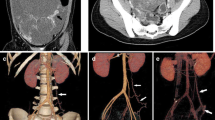Abstract
Purpose
While pelvic congestion syndrome and chronic pelvic pain are relatively common in women, no large- or medium-sized studies have been conducted to our knowledge to evaluate the frequency and severity of ovarian vein dilatation (OVD) on computed tomography (CT). The purpose of our study was therefore to analyze a large number of consecutive abdominal and pelvic CT scans in adult women to determine OVD frequency and severity.
Methods
An IRB-approved, single-institution retrospective analysis of 1042 consecutive abdominal and pelvic CT scans in women ages 25–65 was performed. Scans were evaluated for the presence and severity of OVD and association with “nutcracker anatomy.” A gradation scheme was developed based on quartile analysis.
Results
143 of the CT scans had OVD (13.7%). Of the positive scans, 96 were bilateral, 29 were left-side only, 18 were right-side only, and 18 had nutcracker-type compression of the left renal vein (14.4% of scans with left or bilateral OVD). In positive scans, the mean and median left OVD were 7.5 and 7 mm, respectively, and right-side were 7.2 and 7 mm, respectively. Based on quartile analysis, OVD grading was mild (< 6 mm), moderate (6–8 mm), or severe (> 8 mm), with moderate including the middle 50% of patients.
Conclusions
OVD was found on 13.7% of 1042 consecutive female abdominal and pelvic CT scans, with “nutcracker anatomy” present in 14.4% of the scans with left OVD. Moderate dilatation was defined as an OVD of 6–8 mm at the iliac crests.

Similar content being viewed by others
References
Cura M, Cura A (2009) What is the significance of ovarian vein reflux detected by computed tomography in patients with pelvic pain? Clin Imaging 33(4):306–310
O’Brien MT, Gillespie DL (2015) Diagnosis and treatment of the pelvic congestion syndrome. J Vasc Surg Venous Lymph Dis 3(1):96–106
Tropeano G, Di Stasi C, Amoroso S, Cina A, Scambia G (2008) Ovarian vein incompetence: a potential cause of chronic pelvic pain in women. Eur J Obstet Gynecol Reprod Biol 139(2):215–221
Rozenblit AM, Ricci ZJ, Tuvia J, Amis ED Jr (2001) Incompetent and dilated ovarian veins: a common CT finding in asymptomatic parous women. Am J Roentgenol 176(1):119–122
Grimm LJ, Engstrom BI, Nelson RC, Kim CY (2013) Incidental detection of nutcracker phenomenon on multidetector CT in an asymptomatic population: prevalence and associated findings. J Comput Assist Tomogr 37(3):415–418
Ahlberg NE, Bartley O, Chidekel N (1966) Right and left gonadal vein: an anatomical and statistical study. Acta Radiol Diagn 4(6):593–601
Desimpelaere JH, Seynaeve PC, Hagers YM, Appel BJ, Mortelmans LL (1999) Pelvic congestion syndrome: demonstration and diagnosis by helical CT. Abdom Imaging 21(1):100–102
Kennedy A, Hemingway A (1990) Radiology of ovarian varices. Br J Hosp Med 44(1):38–43
Asciutto G, Asciutto KC, Mumme A, Geier B (2009) Pelvic venous incompetence: reflux patterns and treatment results. Eur J Vasc Endovasc Surg 38(3):381–386
Mettler FA Jr, Thomadsen BR, Bhargavan M, et al. (2008) Medical radiation exposure in the U.S. in 2006: preliminary results. Health Phys 95(5):502–507
Belenky A, Bartal G, Atar E, Cohen M, Bachar GN (2002) Ovarian varices in healthy female kidney donors: incidence, morbidity, and clinical outcome. Am J Roentgenol 179(3):625–627
Whiteley MS (2017) Objective measurements of pelvic venous reflux and stratification of severity of venous reflux in pelvic congestion syndrome due to pelvic venous reflux. Curr Med Res Opin. https://doi.org/10.1080/03007995.2017.1332987
Dos Santos SJ, Holdstock JM, Harrison CC, Lopez AJ, Whiteley MS (2015) Ovarian vein diameter cannot be used as an indicator of ovarian venous reflux. Endovasc Surg 49(1):90–94
Nascimento AB, Mitchell DG, Holland G (2002) Ovarian veins: magnetic resonance imaging findings in an asymptomatic population. J Magn Reson Imaging 15(5):551–556
Kim CY, Miller MJ, Merkle EM (2009) Time-resolved MR angiography as a useful sequence for assessment of ovarian vein reflux. Am J Roentgenol 193(5):e458–e463
Knuttinen MG, Xie K, Jani A, et al. (2015) Pelvic venous insufficiency: imaging diagnosis, treatment approaches, and therapeutic issues. Am J Roentgenol 204:448–458
Yang DM, Kim HC, Nam DH, et al. (2012) Time-resolved MR angiography for detecting and grading ovarian venous reflux: comparison with conventional venography. Br J Radiol 85:e117–e122
Aikimnbaev K, Balli TH, Akgul E, Aksungur AH (2017) Ovarian vein diameters measured by MDCT in women without evidence of pelvic congestion syndrome. Heart Vessels Transplant 1:43–48
Acknowledgements
None.
Author information
Authors and Affiliations
Corresponding author
Ethics declarations
Funding
No funding was utilized for this study.
Conflict of interest
All the authors declare that they have no conflict of interest.
Ethical approval
All procedures performed in studies involving human participants were in accordance with the ethical standards of the Institutional and/or National Research Committee and with the 1964 Helsinki Declaration and its later amendments of comparable ethical standards.
Rights and permissions
About this article
Cite this article
Szaflarski, D., Sosner, E., French, T.D. et al. Evaluating the frequency and severity of ovarian venous congestion on adult computed tomography. Abdom Radiol 44, 259–263 (2019). https://doi.org/10.1007/s00261-018-1707-9
Published:
Issue Date:
DOI: https://doi.org/10.1007/s00261-018-1707-9




